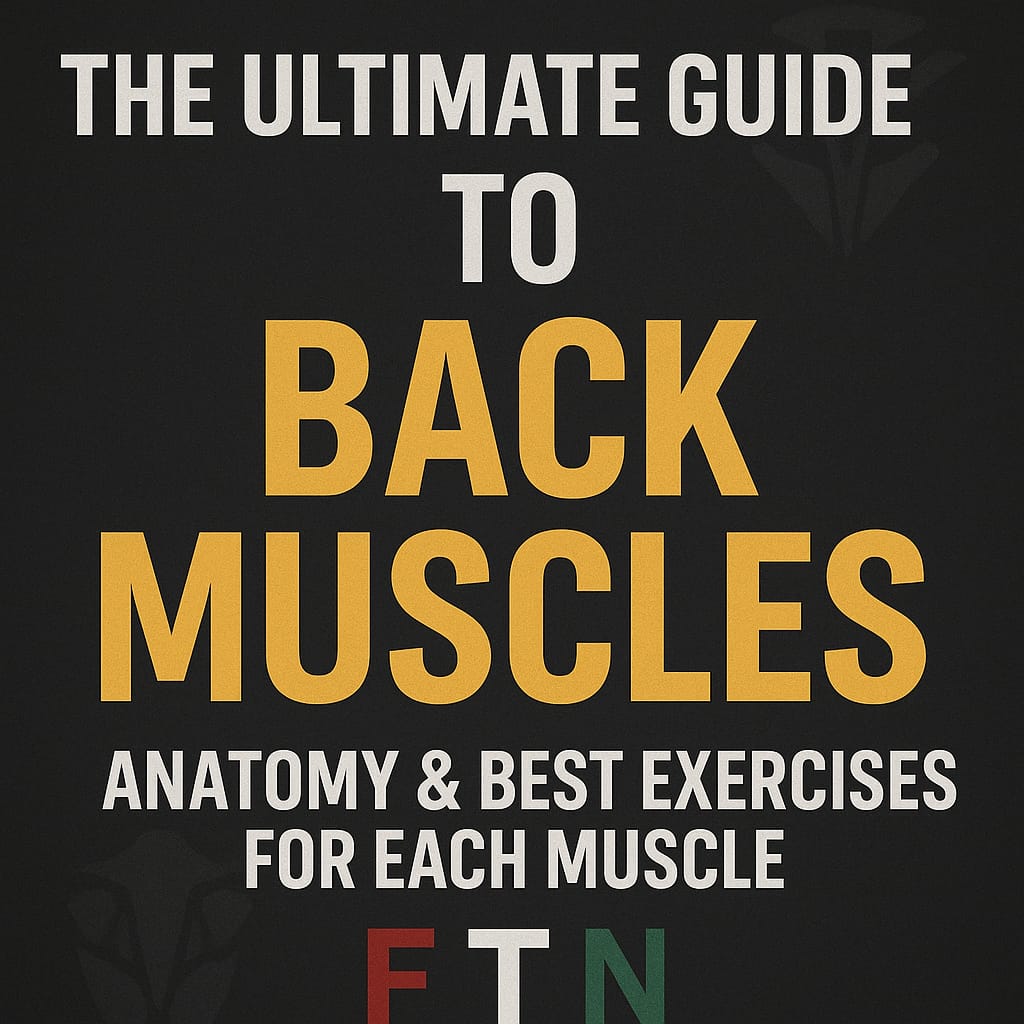A strong, well-developed back isn’t just about aesthetics — it’s the foundation of strength, posture, and athletic performance. Whether you’re lifting weights, sitting at a desk, or performing everyday activities, your back muscles play a critical role in stability and movement.
In this guide, we’ll explore the anatomy of the back muscles, understand their unique functions, and learn the best exercises to train each one effectively. Whether you’re a beginner or seasoned athlete, this knowledge will help you build a balanced, powerful, and pain-free back 💥.
🔍 Understanding Back Muscle Anatomy
Your back is made up of a complex, layered system of muscles, divided into:
Superficial muscles (responsible for large movements like pulling and lifting)
Intermediate muscles (support respiration and trunk stability)
Deep muscles (control posture and fine motor movement)
These layers work together to:
✅ Maintain an upright posture
✅ Support the spine
✅ Enable twisting, bending, and lifting
✅ Prevent injuries in both workouts and daily activities
Knowing which muscles you’re training ensures you’re not just working out harder — you’re working out smarter.
🔩 Major Back Muscles and Their Functions
Let’s break down the key muscle groups that shape and power your back:
1. 🦅 Latissimus Dorsi (Lats)
Location: From the mid/lower spine to the upper arms
Function: Shoulder adduction, extension, and internal rotation
Activated in: Pull-ups, lat pulldowns, bent-over rows
2. ⚙️ Trapezius (Traps)
Location: From the base of the skull to the mid-back
Function: Lifting, rotating, and stabilizing the scapula
Activated in: Shrugs, upright rows, face pulls
3. 🎯 Rhomboids
Location: Between shoulder blades
Function: Scapular retraction (pulling shoulder blades together)
Activated in: Rows, reverse flies, face pulls
4. 🧱 Erector Spinae
Location: Runs along the spine
Function: Extends and stabilizes the spine, supports posture
Activated in: Deadlifts, back extensions, good mornings
Each of these muscles is critical for total-body function, not just back aesthetics.
🏋️♂️ Latissimus Dorsi: Anatomy + Best Exercises
The lats are wide, wing-shaped muscles that help you pull and lift. They’re vital for upper body strength and create that V-tapered look many strive for.
✅ Best Lat Exercises:
Pull-Ups: Wide grip for maximum lat activation
Lat Pulldown: Cable-based version for controlled strength building
Bent-Over Rows: Builds depth and size; can use barbell or dumbbells
🔥 Tip: Keep your chest lifted and shoulder blades retracted to isolate the lats during each movement.
🧠 Trapezius: Structure + Strength Training
The trapezius spans your upper back and shoulders, split into upper, middle, and lower sections. Each region has unique functions:
Upper traps: Elevate the shoulders (e.g., shrugs)
Middle traps: Retract the scapula (e.g., rows)
Lower traps: Depress the scapula (e.g., face pulls)
✅ Top Trap Exercises:
Shrugs: Targets upper traps directly
Upright Rows: Engages both upper and middle traps
Face Pulls: Strengthens lower traps and rear delts
💡 Maintaining strong traps can reduce neck strain and improve shoulder alignment.
🧩 Rhomboids: Muscle Function + Targeted Movements
Often overlooked, the rhomboids are critical for good posture and shoulder mobility.
✅ Effective Rhomboid Exercises:
Reverse Flies: Great for scapular retraction
Face Pulls: Enhances posture and shoulder stability
Bent-Over Dumbbell Rows: Excellent for upper back thickness
🎯 Form Tip: Squeeze your shoulder blades together at the top of each movement to fully activate the rhomboids.
🧍♂️ Erector Spinae: The Posture Powerhouse
The erector spinae muscles run the full length of your spine. They’re the key to upright posture, spine stabilization, and safe lifting mechanics.
✅ Best Exercises:
Deadlifts: King of back exercises, engages the entire posterior chain
Back Extensions: Focuses directly on lower spinal strength
Good Mornings: Combines flexibility with lower back strength
💥 Pro Tip: Always maintain a neutral spine during these movements to prevent lower back injury.
📊 Sample Back Workout Routine
This back-focused workout targets all major muscle groups and builds both size and stability.
🔁 Warm-Up (5–10 mins):
Rowing machine or jumping jacks
Dynamic stretches (arm swings, torso rotations)
🏋️♀️ Main Workout:
| Exercise | Sets | Reps | Target Muscle |
|---|---|---|---|
| Pull-Ups | 3 | 6–10 | Lats |
| Barbell Rows | 3 | 8–12 | Middle Back |
| Lat Pulldowns | 3 | 10–15 | Lats |
| Face Pulls | 3 | 12–15 | Traps/Rhomboids |
| Deadlifts | 3 | 6–10 | Erector Spinae |
🧘♂️ Cooldown:
Static stretches (cat-cow, child’s pose)
Foam rolling the upper and lower back
⏱️ Rest 60–90 seconds between sets. Adjust reps and weights based on fitness level.
❌ Common Mistakes to Avoid
Training your back effectively isn’t just about lifting heavy — it’s about doing it right. Avoid these pitfalls:
⚠️ 1. Poor Form
Rounding the back during deadlifts or rows can lead to serious injury
Always keep a neutral spine and engage your core
⚠️ 2. Neglecting Certain Muscles
Don’t focus only on the lats. Include rhomboids, traps, and erector spinae exercises
⚠️ 3. Skipping Recovery
Muscles grow during rest
Get enough sleep, hydrate, and avoid training the same muscle group every day
🧠 Smart training = Better results + fewer injuries.
📈 Why You Should Prioritize Back Training
Here’s why a strong back matters more than you think:
✅ Better posture
✅ Reduced back and shoulder pain
✅ Improved lifting performance
✅ Enhanced sports performance
✅ Balanced physique
No matter your fitness goal — fat loss, muscle gain, or athletic performance — back training is non-negotiable.
🧠 Final Thoughts: Train Smart, Build Strong
The back muscles are some of the most powerful and functional in your entire body. Whether you’re reaching for a shelf, pulling a heavy bag, or chasing gains in the gym, your back is involved.
By understanding the anatomy, practicing proper form, and incorporating balanced training, you’ll build a back that’s not only strong and stable — but resilient for life 💯.
A video like “The Ultimate Guide to Back Muscles” is a goldmine for anyone serious about building a strong, symmetrical, and injury-resistant back. Most people train back with generic pull-downs or rows, but without understanding the anatomy, they leave a lot of growth potential untapped.
✅ What makes this video stand out:
It breaks down the major muscle groups — like the latissimus dorsi, trapezius, rhomboids, erector spinae, and teres major/minor — and connects each one to specific exercises. This is what turns average training into intelligent training.
🧠 From a coach’s perspective:
When you know what muscle does what, you can choose exercises based on function — not just feeling. For example:
Want a wider back? Focus on lat isolation with movements like straight-arm pulldowns or neutral-grip pull-ups.
Want thickness? Prioritize mid-back activation with bent-over rows or chest-supported T-bar rows.
Want posture and lower back strength? Train the erector spinae with Romanian deadlifts and back extensions.
🔥 Key takeaway for viewers:
Don’t just “train back.” Train each part of the back with intention. Understand the role of each muscle, its movement pattern, and match it with the right load and form.

